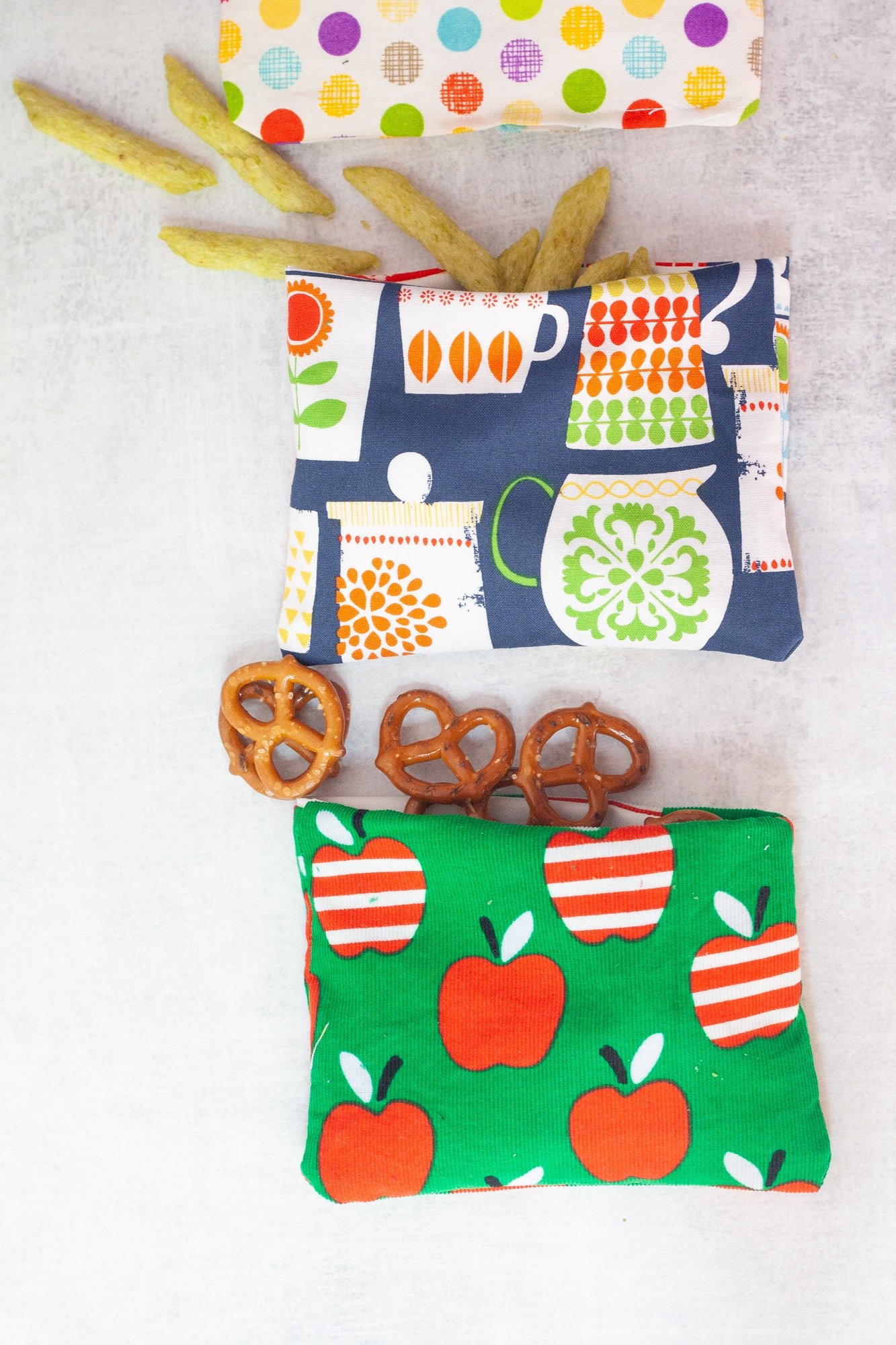Snacks are a big deal in our house. With two little kids, any time an adventure or errand keeps us out of the house for more than 90 minutes or so, I need to pack a snack. Containers can be too bulky, and I hate the waste that comes from single-serve packets or using plastic bags. Reusable snack bags are the answer!

The Ultimate Guide to Healthy School Lunches
We’ve packed (pun intended!) all our knowledge from years of making school lunches into one digital master guide!
They are a breeze to make! These go very, very quickly if you assembly line them. I made these three in about 30 minutes.
You may remember that we’ve talked about reusable snack bags on Wholefully before. In that version, we ironed a piece of vinyl to a cotton liner. But in the eight years since that tutorial was posted, we realized that there might be some food safety concerns with the vinyl coming into contact with food. So we’re updating it today with food-safe fabric—which also conveniently cuts out a few steps from the tutorial. And as a bonus, this liner is waterproof, which means you can even use these to pack snacks like fruits and vegetables. I just used mine the other day for bell pepper slices!

Materials for Making Reusable Snack Bags:
- Outside cotton fabric—dig through your fabric stash! You just need enough to make two 6 1/2”x5″ rectangles
- Waterproof food-safe fabric (I used this ProCare Waterproof Food Safe Fabric)
- Velcro
- Coordinating thread
- Scissors
- Ruler
- Seam gauge
- Rotary cutter and mat (optional, but makes this project even quicker!)
How to Make Reusable Snack Bags:
Cut your fabric. Cut two pieces each of the outer fabric and the liner—I used 6 1/2″ x 5″ and thought that was a good snack size. But any size will work! Cut a strip of the Velcro/hook and loop fastener to 6 1/2″ (or whatever width your bag will be).

2. Pin one half of the velcro strip 3/4″ from the top of one liner piece, and sew all around the edges of the fastener. You may be tempted to not pin, but that vinyl gets slippery. Trust me, even if you tend to freehand your sewing, you want to pin in this case.
Repeat with the other piece of lining fabric and the other half of the hook-and-loop fastener.

3. Pin one piece of the lining fabric to one piece of the outer fabric, right sides together (for the lining, the “right side” is the one with the fastener on it). Sew along the top, 1/4″ from the edge.
Repeat with the other lining and outside fabric piece. Open up both pieces and run your finger along the seams to press them open. You’d usually want to iron here, but the liner won’t hold up high heat, and I didn’t want to risk it. So finger pressing it was!


4. Put together both pieces, right sides together, matching up the seams and the Velcro. Starting at the bottom of the lining fabric, sew around the perimeter of the piece, leaving a 2″ space open at the bottom of the liner to turn the bag. Backstitch at each end of your sewing.

5. Turn the bag right-side-out through the opening in the bottom of the liner.
6. Close the opening at the bottom of the liner by folding in the edges to create a seam. You can either topstitch over this, or slipstitch it. Since nobody is going to be looking that closely at the inside of these bags (and if they are, they are probably just looking for more snacks!), I went ahead and topstitched these.


7. Push the liner inside the bag, and you’re done! To make the bags lay flat, you may want to either finger press the top seams or briefly run over the bags with a very low iron. Like I said, heat isn’t great for the liner fabric, but I figured using a low iron on the outside of the bags for just a few seconds wouldn’t heat the liner up much, if at all.
Cleaning Your Snack Bags
Most of the time, you can just turn the bags inside out and wipe off any crumbs or juice. But if it gets really dirty, wash in cold water and hang up to dry. If you put these through the washer, I recommend putting them in a mesh laundry bag first, just so the Velcro doesn’t snag on the rest of your laundry.
Using Your Extra Liner Fabric
The smallest amount of the ProCare Waterproof Food Safe fabric you can get online is 1/2 yard, which will make you about a dozen snack bags at this size. If you don’t need a giant stash of reusable snack bags, a set of these would make a great gift or stocking stuffer!




